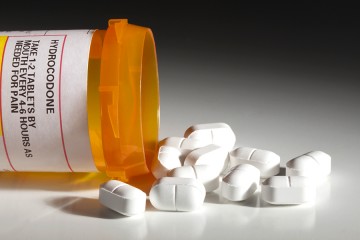Opioid prescription use in the U.S. rose significantly between 1999 and 2014, with much of that increase coming from patients who had been taking their medication for 90 days or longer, according to a new study by researchers at the Johns Hopkins Bloomberg School of Public Health.
Long-term use, which is associated with greater risk for addiction and overdose, increased threefold during the study's 16-year time frame. In 1999-2000, less than half of the people who were taking prescription opioids were taking them for 90 days or more. By 2013-2014, more than 70 percent were taking opioid medication on a long-term basis.
The findings come as the U.S. grapples with a worsening opioid epidemic that kills nearly 100 people a day on average, some from prescription opioids and others from illegal forms, primarily heroin. Last month, the Trump administration declared the opioid epidemic a public health emergency, a step that will allow the government to dispense additional federal funds for treatment.
The study, published online today in the journal Pharmacoepidemiology and Drug Safety, draws from survey data gathered by the National Health and Nutritional Examination Survey, conducted every two years since 1999-2000. Prescription opioid use, the paper found, rose from 4.1 percent of U.S. adults in 1999-2000 to 6.8 percent in 2013-2014, an increase of 60 percent. Long-term prescription opioid use, defined as 90 days or more, increased from 1.8 percent in 1999-2000 to 5.4 percent in 2013-2014.
"What's especially concerning is the jump in long-term prescription opioid use, since it's linked to increased risks for all sorts of problems, including addiction and overdoses," says study author Ramin Mojtabai, a professor in the Department of Mental Health at the Bloomberg School. "The study also found that long-term use was associated with heroin use as well as the concurrent use of benzodiazepines, a class of widely prescribed drugs that affect the central nervous system."
This is one of the paper's more worrisome findings, Mojtabai notes, since combining opioids and benzodiazepines significantly increases the risk of overdose, even if the patient is taking a moderate dosage of opioid medication. Combining these drugs can also cause respiratory suppression, he says.
For the paper, Mojtabai examined eight consecutive biannual surveys, each of which included more than 5,000 adults living throughout the United States. A total of 47,356 adults participated in the eight surveys, and the response rate ranged from 71 percent to 84 percent.
Despite the upward trend, there is scant evidence supporting benefits of longer-term prescription opioid use, Mojtabai says, with no randomized clinical trials that support their extended use, given the risks.
Prescription opioids were originally designed for shorter-term use, which involves fewer patient risks. Many patients who take opioid medication for weeks or months develop a tolerance that over time requires higher dosages for the medication to relieve pain. As a result, patients will take more medication to reduce their pain, setting them on the path to possible addiction. While there is no clear delineation as to when addiction kicks in, longer-term use is thought to be a risk factor.
The Centers for Disease Control and Prevention issued new guidelines last year, recommending that physicians prescribe opioids for chronic pain only after other options have been proven ineffective. The guidelines also recommend short-term use (three days instead of seven) and lower dosages. The impact of these new guidelines is not yet known, Mojtabai says.
"Given the urgency, it's critical that we continue to try and understand what benefits, if any, exist for prescribing opioids for both short- but especially for longer-term consumption," says Mojtabai. "There may be alternative treatments. We also need to understand what other factors contribute to the considerable risks of prescription opioid medication among different groups, especially those with other drug or alcohol use in their profiles."
Read more from School of Public HealthTagged prescription drugs, opioids, drug abuse










